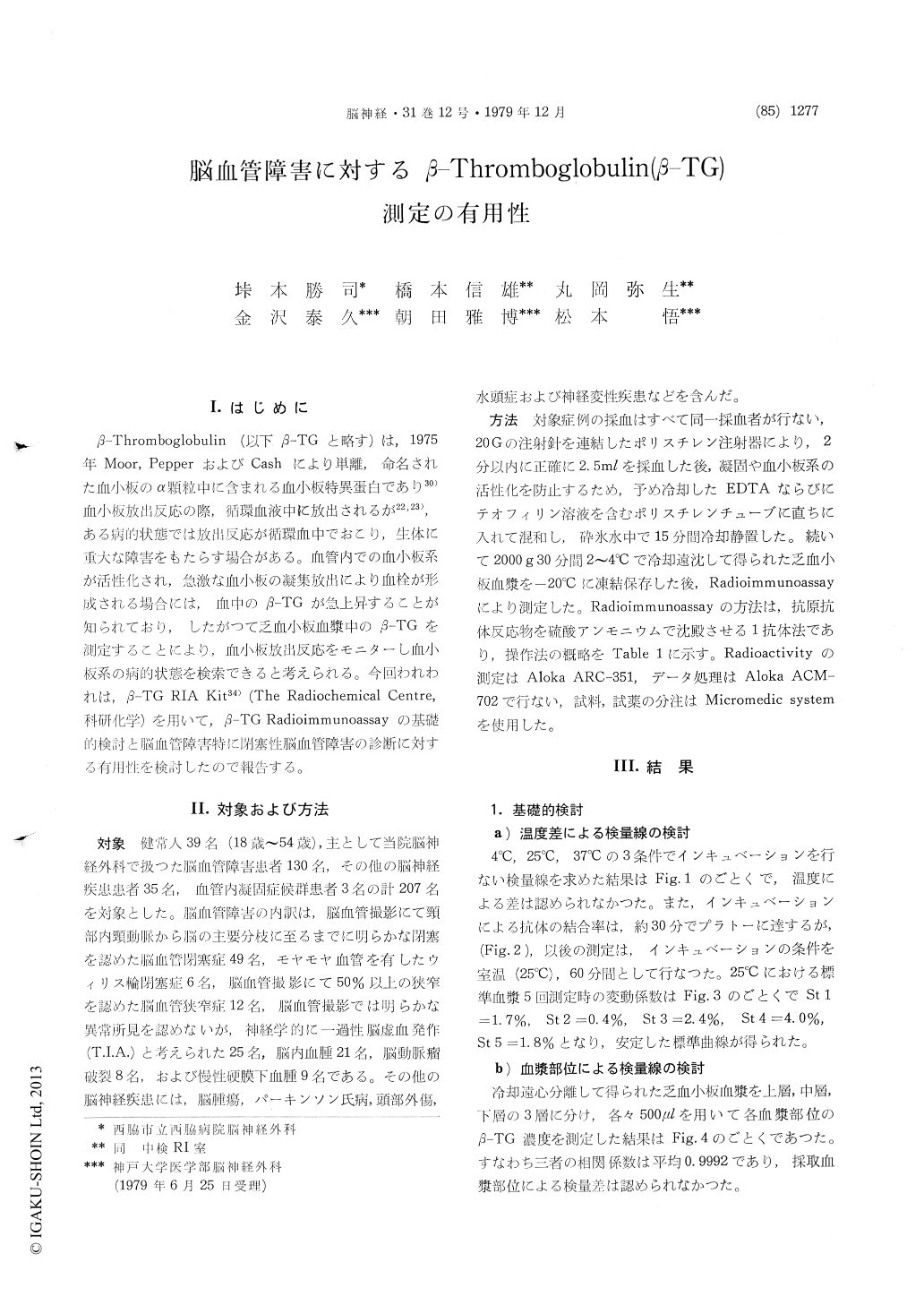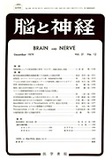Japanese
English
- 有料閲覧
- Abstract 文献概要
- 1ページ目 Look Inside
Ⅰ.はじめに
β—Thromboglobulin (以下β—TGと略す)は、1975年Moor,PepperおよびCashにより単離,命名された血小板のα顆粒中に含まれる血小板特異蛋白であり30)血小板放出反応の際,循環血液中に放出されるが22,23),ある病的状態では放出反応が循環血中でおこり,生体に重大な障害をもたらす場合がある。血管内での血小板系が活性化され,急激な血小板の凝集放出により血栓が形成される場合には、血中のβ—TGが急上昇することが知られており,したがつて乏血小板血漿中のβ—TGを測定することにより,血小板放出反応をモニターし血小板系の病的状態を検索できると考えられる。今回われわれは、β—TG RIA Kit34)(The Radiochemical Centre,科研化学)を用いて,β—TG Radioimmunoassayの基礎的検討と脳血管障害特に閉塞性脳血管障害の診断に対する有用性を検討したので報告する。
A platelet protein which was termed β-Throm-boglobulin (β-TG) by Moor et al., has an approxi-mate molecular weight of 36,000 which dissociated in 6 subunits under acid condition. It is thought to be a platelet specific protein, and said that plasma β-TG concentration is raised on the platelet release reaction in vivo. Recently, it has become to measure the concentration of β-TG in platelet-poor plasma by radioimmunoassay. However, because the assay is relatively new, only limited numbers of clinical trials have been carried out.
We have examined the stability and physico-chemical properties of β-TG RIA Kit (Radiochemi-cal Centre) and also measured the plasma β-TG concentration in 39 normal subjects and 168 various neurological diseases, especially cerebrovascular di-seases in clinical studies.
Influence of incubation temperature between 4℃ and 37℃ on the standard curves of β-TG was negligible, and difference of β-TG concentration in different portion of a same plasma was not remark-able. In addition, our results about intra- and in-terassay reproducibility of the β-TG RIA Kit were satisfactory and mean recovery rate of variousamount of added to a sample was 116.8%. So β-TG RIA Kit was thought to be stable.
In clinical studies, we have measured concentra-tion of plasma β-TG of 207 cases during about 10 months. The mean level in platelet-poor plasma from normal adults was found to be about 22.3 ng/ ml with a range from 6 to 48 ng/ml. Among 49 patients of recent cerebrovascular occulsion, raised plasma β-TG concentration have been found in many cases which mean level was 135.8 ng/ml. In 6 Moya-Moya diseases, highest β-TG concentration which mean level was 192.9 ng/ml have been ob-tained, and high plasma concentration of β-TG was also obtained in many T.I.A. patients which mean level was 112.3 ng/ml.
On the other hand, normal plasma β-TG con-centration have been obtained in almost all hemor-rhagic cerebrovascular diseases such as intracerebral hematomas and aneurysms, and also in other neuro-logical diseases such as brain tumors, hydrocephalus, head injuries, Parkinson disease and so on.
In about one-third patients of obstructive cerebro-vascular diseases, raised plasma β-TG concentration had returned to normal by the treatment with aspirin. However, treatment with dipyridamole did not seem so effective as that of aspirin from the measuring point of view.
The measurement of plasma β-TG concentration seems to be not only a useful new method to di-agnose thrombotic cerebrovascular diseases but also a supplementary method to know the therapeutic effect or its prognosis, although many research about definit function associated with β-TG are subjects in the future study, because it is still un-known whether the hypercoagulality predisposes to the thrombus formation or whether the presence of thrombus causes activation of the circulating platelets.

Copyright © 1979, Igaku-Shoin Ltd. All rights reserved.


